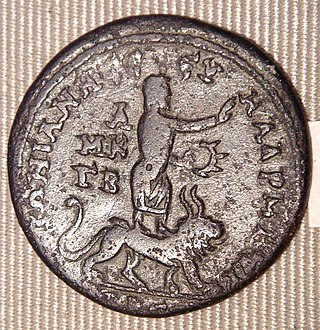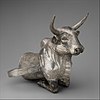Related Research Articles

The Anatolian languages are an extinct branch of Indo-European languages that were spoken in Anatolia, part of present-day Turkey. The best known Anatolian language is Hittite, which is considered the earliest-attested Indo-European language.
Lydian is an extinct Indo-European Anatolian language spoken in the region of Lydia, in western Anatolia. The language is attested in graffiti and in coin legends from the late 8th century or the early 7th century to the 3rd century BCE, but well-preserved inscriptions of significant length are so far limited to the 5th century and the 4th century BCE, during the period of Persian domination. Thus, Lydian texts are effectively contemporaneous with those in Lycian.

The Lycian language was the language of the ancient Lycians who occupied the Anatolian region known during the Iron Age as Lycia. Most texts date back to the fifth and fourth century BC. Two languages are known as Lycian: regular Lycian or Lycian A, and Lycian B or Milyan. Lycian became extinct around the beginning of the first century BC, replaced by the Ancient Greek language during the Hellenization of Anatolia. Lycian had its own alphabet, which was closely related to the Greek alphabet but included at least one character borrowed from Carian as well as characters proper to the language. The words were often separated by two points.

Luwian, sometimes known as Luvian or Luish, is an ancient language, or group of languages, within the Anatolian branch of the Indo-European language family. The ethnonym Luwian comes from Luwiya – the name of the region in which the Luwians lived. Luwiya is attested, for example, in the Hittite laws.

Hittite, also known as Nesite, is an extinct Indo-European language that was spoken by the Hittites, a people of Bronze Age Anatolia who created an empire centred on Hattusa, as well as parts of the northern Levant and Upper Mesopotamia. The language, now long extinct, is attested in cuneiform, in records dating from the 17th to the 13th centuries BC, with isolated Hittite loanwords and numerous personal names appearing in an Old Assyrian context from as early as the 20th century BC, making it the earliest attested use of the Indo-European languages.
In Indo-European linguistics, the term Indo-Hittite refers to Edgar Howard Sturtevant's 1926 hypothesis that the Anatolian languages may have split off a Pre-Proto-Indo-European language considerably earlier than the separation of the remaining Indo-European languages. The term may be somewhat confusing, as the prefix Indo- does not refer to the Indo-Aryan branch in particular, but is iconic for Indo-European, and the -Hittite part refers to the Anatolian language family as a whole.
I-mutation is a type of sound change in which a back vowel is fronted or a front vowel is raised if the following syllable contains, or. It is a category of regressive metaphony, or vowel harmony.

Anatolian hieroglyphs are an indigenous logographic script native to central Anatolia, consisting of some 500 signs. They were once commonly known as Hittite hieroglyphs, but the language they encode proved to be Luwian, not Hittite, and the term Luwian hieroglyphs is used in English publications. They are typologically similar to Egyptian hieroglyphs, but do not derive graphically from that script, and they are not known to have played the sacred role of hieroglyphs in Egypt. There is no demonstrable connection to Hittite cuneiform.

The Anatolians were Indo-European-speaking peoples of the Anatolian Peninsula in present-day Turkey, identified by their use of the Anatolian languages. These peoples were among the oldest Indo-European ethnolinguistic groups and one of the most archaic, because Anatolians were among the first Indo-European peoples to separate from the Proto-Indo-European community that gave origin to the individual Indo-European peoples.

Proto-Anatolian is the proto-language from which the ancient Anatolian languages emerged. As with almost all other proto-languages, no attested writings have been found; the language has been reconstructed by applying the comparative method to all the attested Anatolian languages as well as other Indo-European languages.

Hieroglyphic Luwian (luwili) is a variant of the Luwian language, recorded in official and royal seals and a small number of monumental inscriptions. It is written in a hieroglyphic script known as Anatolian hieroglyphs.
The Luwians were an ancient people in Anatolia who spoke the Luwian language. During the Bronze Age, Luwians formed part of the population of the Hittite Empire and adjoining states such as Kizzuwatna. During the Hittite New Kingdom, Luwian replaced Hittite as the empire's dominant language. In the early Iron Age, a number of Luwian-speaking Neo-Hittite states arose in northern Syria. The Luwians are known largely from their language, and it is unclear to what extent they formed a unified cultural or political group.
The following is a table of many of the most fundamental Proto-Indo-European language (PIE) words and roots, with their cognates in all of the major families of descendants.

Šanta (Santa) was a god worshiped in Bronze Age Anatolia by Luwians and Hittites. It is presumed that he was regarded as a warlike deity, and that he could additionally be associated with plagues and possibly with the underworld, though the latter proposal is not universally accepted. In known texts he frequently appears alongside Iyarri, a deity of similar character. He is first attested in documents from Kanesh dated to the Old Assyrian period, and continues to appear in later treaties, ritual texts and theophoric names. He is also present in an offering lists from Emar written in Akkadian, though he did not belong to the local pantheon and rituals involving him were only performed on behalf of the Hittite administration by local inhabitants.
The grammar of the Hittite language has a highly conservative verbal system and rich nominal declension. The language is attested in cuneiform, and is the earliest attested Indo-European language.

Pala was a Bronze Age country in Northern Anatolia. Little is known of Pala except its native Palaic language and its native religion. Their language shared common innovations with Luwian not present in the Hittite language suggesting a prior Luwian-Palaic linguistic complex.

Tiwaz was the Luwian Sun-god. He was among the most important gods of the Luwians.

Tarḫunna or Tarḫuna/i was the Hittite weather god. He was also referred to as the "Weather god of Heaven" or the "Lord of the Land of Hatti".
Ziparwa, originally known as Zaparwa, was the head of the pantheon of the Palaians, inhabitants of a region of northern Anatolia known as Pala in the Bronze Age. It is often assumed that he was a weather god in origin, though he was also associated with vegetation. Information about the worship of Ziparwa comes exclusively from Hittite texts, though some of them indicate that formulas in Palaic were used during festivals dedicated to him held in Hittite cities such as Hattusa.
Tiyaz or Tiyad was the sun god of the Palaians, regarded as the third most important deity in their pantheon. He was also incorporated into Hittite religion. He appears in a ritual written in Palaic, though presumed to belong to a Hittite corpus, in which he is implored to anoint the king. After the fall of the Hittite Empire, he might have been worshiped by Phrygians.
References
- ↑ Burney, Charles (2004). Historical Dictionary of the Hittites. Scarecrow Press. p. 223. ISBN 0810865645.
- ↑ Kloekhorst, Alwin (2022). "Anatolian". The Indo-European Language Family. pp. 63–82. doi:10.1017/9781108758666.005. ISBN 978-1-108-75866-6.
- ↑ Carruba, O. Das Palaische. Texte, Grammatik, Lexikon. Wiesbaden: Harrassowitz, 1970. StBoT 10.
- 1 2 3 Melchert, H. Craig (2008). "Palaic". The Ancient Languages of Asia Minor. pp. 40–45. doi:10.1017/CBO9780511486845.007. ISBN 978-0-521-68496-5.
- ↑ Melchert, H. C. (1994). "Palaic Phonology". Anatolian Historical Phonology. Leiden, The Netherlands: Brill. pp. 190–208. doi:10.1163/9789004657335_008. ISBN 978-90-04-65733-5.
- ↑ The Indo-European Language Family: A Phylogenetic Perspective, p. 7. N.p., Cambridge University Press, 2022.
- ↑ Melchert, Harold Craig. Anatolian historical phonology, p.10. Netherlands, Rodopi, 1994.
- ↑ Sasseville, David. Anatolian Verbal Stem Formation: Luwian, Lycian and Lydian. Netherlands, Brill, 2020, p. 528.
